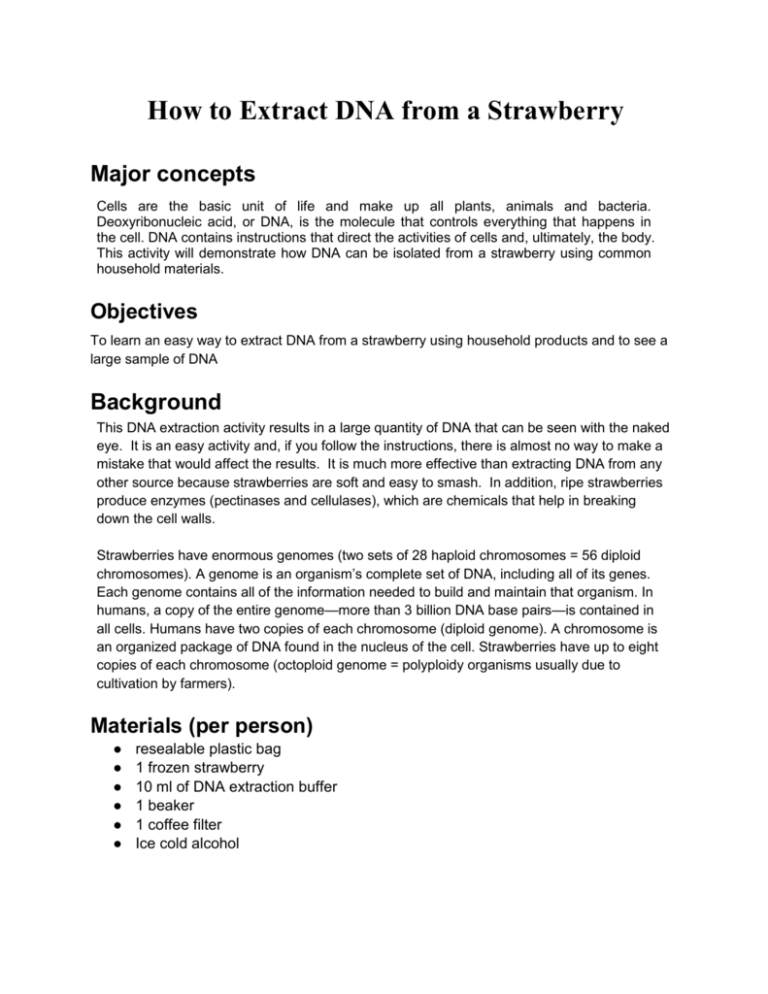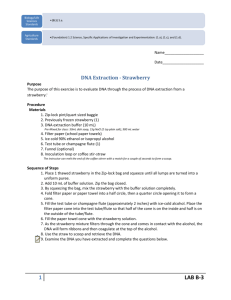Strawberry DNA Extraction Lab
advertisement

How to Extract DNA from a Strawberry Major concepts Cells are the basic unit of life and make up all plants, animals and bacteria. Deoxyribonucleic acid, or DNA, is the molecule that controls everything that happens in the cell. DNA contains instructions that direct the activities of cells and, ultimately, the body. This activity will demonstrate how DNA can be isolated from a strawberry using common household materials. Objectives To learn an easy way to extract DNA from a strawberry using household products and to see a large sample of DNA Background This DNA extraction activity results in a large quantity of DNA that can be seen with the naked eye. It is an easy activity and, if you follow the instructions, there is almost no way to make a mistake that would affect the results. It is much more effective than extracting DNA from any other source because strawberries are soft and easy to smash. In addition, ripe strawberries produce enzymes (pectinases and cellulases), which are chemicals that help in breaking down the cell walls. Strawberries have enormous genomes (two sets of 28 haploid chromosomes = 56 diploid chromosomes). A genome is an organism’s complete set of DNA, including all of its genes. Each genome contains all of the information needed to build and maintain that organism. In humans, a copy of the entire genome—more than 3 billion DNA base pairs—is contained in all cells. Humans have two copies of each chromosome (diploid genome). A chromosome is an organized package of DNA found in the nucleus of the cell. Strawberries have up to eight copies of each chromosome (octoploid genome = polyploidy organisms usually due to cultivation by farmers). Materials (per person) ● ● ● ● ● ● resealable plastic bag 1 frozen strawberry 10 ml of DNA extraction buffer 1 beaker 1 coffee filter Ice cold alcohol Shampoo or dishwasher soap helps to dissolve the cell membrane, which is a lipid bilayer. Sodium chloride (table salt) helps to remove proteins that are bound to the DNA. It also helps to keep the proteins dissolved in the aqueous layer so they don’t precipitate in the alcohol along with the DNA. Ethanol or isopropyl alcohol causes the DNA to precipitate. When DNA comes out of solution it tends to clump together, which makes it visible. The long strands of DNA will wrap around the stirrer or transfer pipet when it is swirled at the interface between the two layers. Procedures 1. Pull off any green leaves on the strawberry that have not been removed yet. 2. Put the strawberry into the plastic bag, seal it and gently smash it for about two minutes. 3. Completely crush the strawberry. This starts to break open the cells and release the DNA. 4. When you have finished smashing, add 10 ml of the DNA extraction buffer into the bag. 5. Carefully press out all of the air, reseal the bag and gently smash for another minute (Avoid making too many soap bubbles). 6. Place the coffee filter over the top of a cup or beaker. 7. Open the bag and pour the strawberry liquid into the filter. You can twist the filter just above the liquid and gently squeeze the remaining liquid into the cup. ****Take time to observe what the strawberry and extract mixture looks like before the next step. 8. Next, pour down the side of the cup an equal amount of cold rubbing alcohol as there is strawberry liquid. Do not mix or stir. You have just isolated the DNA from the rest of the material contained in the cells of the strawberry. 9. Within a few seconds, watch for the development of a white cloudy substance (DNA) in the top layer above the strawberry extract layer. 10. Tilt the cup and pick up the DNA using a glass rod. Spool the DNA by twirling the glass rod through the DNA. 11. The DNA will look like mucus or egg whites. As it dries, it will look like a spider web. The fibers contain millions of DNA strands! 12. Sketch the test tube with its contents using a drawing program on your computer. Save the drawing as a .jpg and upload to your google lab report/write-up (Insert in question 5 of your write-up). 13. Create a wet mount slide with your DNA and observe the DNA under the microscope. Again, draw a picture of what you see under the three lowest objective lenses. Save these drawings as .jpgs and upload to your lab report/write-up. (Insert in question 6 of your write-up). Lab Report/Write-up Questions 1. Explain the purpose of squishing the fruit into a slush in the plastic bag. 2. Explain the purpose of filtering the extract through a coffee filer. 3. Explain the purpose of adding the DNA extraction solution that is made up of soap, salt and water. 4. Explain the purpose of adding the cold alcohol over the strawberry extract mixture. 5. Insert the drawing you did of the strawberry, extract and alcohol in the beaker. 6. Insert the 3 lowest objective drawings here. 7. Describe in words what the DNA looked like when it was all clumped together and floating in solution. 8. DNA is soluble in water, but not in ethanol. What does this fact have to do with our method of extraction? Explain what happened when the ethanol came in contact with the strawberry extract. 9. Explain why DNA the not the same in all cells in the human body? 10. Describe one reason why scientists might want to study the DNA of strawberries. 11. Restate the purpose of this lab. 12. Explain briefly the steps you took during this lab. 13. What results did you get from doing this lab? 14. What uncertainties resulted from this lab? 15. What 3 new pieces of information did you learn from this lab?








